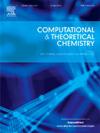Evaluating the drug delivery and sensing performance of XB23N24, (X = B, Al, Ga) nanocages for gemcitabine anticancer drug
IF 3
3区 化学
Q3 CHEMISTRY, PHYSICAL
引用次数: 0
Abstract
The interaction of pristine B24N24 nanocages and their Al and Ga-doped nanocages with gemcitabine (GEM) drug was evaluated using density functional theory (DFT) to evaluate BN nanocages for the purpose of GEM nanosensors and drug delivery vehicles. GEM undergoes adsorption on the nanocages either on the boron atom or on the dopant atom. The domain-based local pair natural orbital (DLPNO)-based coupled-cluster method with single, double, and triple excitations (CCSD(T)) based calculations show that the adsorption energy of the drug was −31.79, −61.51, and − 59.60 kcal mol−1 for bare B24N24 and Al and Ga doped nanocages. The doping of metals has enhanced the dipole moment, and the complexes were found to have higher solvation energy than gemcitabine, which helps to improve the solubility and bioavailability of GEM. The highest occupied molecular orbital (HOMO), lowest unoccupied molecular orbital (LUMO) and HOMO-LUMO energy gap were sensitive to the dopant atom, and the low energy gap was found for the GEM/B24N24 complex with a substantial increase in electrical conductivity. Noncovalent interaction analysis shows that the hydrogen atom of the amide group in GEM makes a bond with the nanocage, which would reduce the deamination of the group and thereby increase the half-life of the drug. Calculations indicate that the half-life of the drug can be modulated using the judicious choice of attempted frequency and dopant metal atom. The UV–visible spectra of GaB23N24 nanocage were found to show substantial redshift when GEM is adsorbed on it and could, therefore, be a photosensor. The surge of work function upon the adsorption of GEM on B24N24 supports the pristine nanocage, which could be a work function (Φ) type electronic sensor used to detect GEM. Thus, B24N24 nanocages are promising devices for work function-type electronic sensors and Ga-doped nanocages as photosensors and drug carriers.

求助全文
约1分钟内获得全文
求助全文
来源期刊

Computational and Theoretical Chemistry
CHEMISTRY, PHYSICAL-
CiteScore
4.20
自引率
10.70%
发文量
331
审稿时长
31 days
期刊介绍:
Computational and Theoretical Chemistry publishes high quality, original reports of significance in computational and theoretical chemistry including those that deal with problems of structure, properties, energetics, weak interactions, reaction mechanisms, catalysis, and reaction rates involving atoms, molecules, clusters, surfaces, and bulk matter.
 求助内容:
求助内容: 应助结果提醒方式:
应助结果提醒方式:


